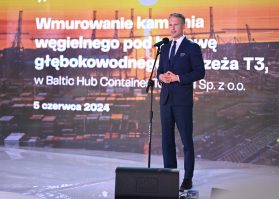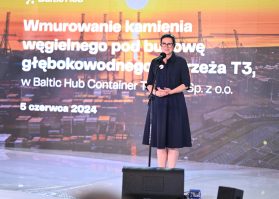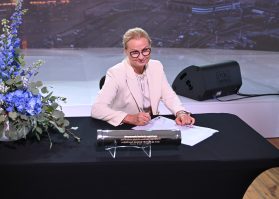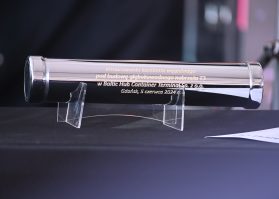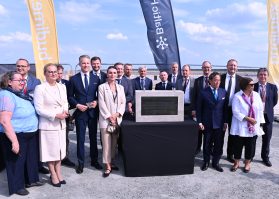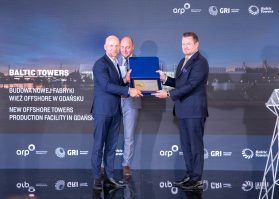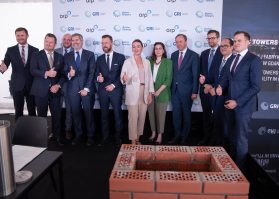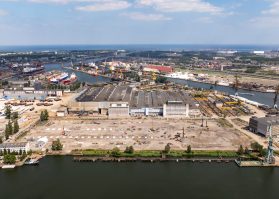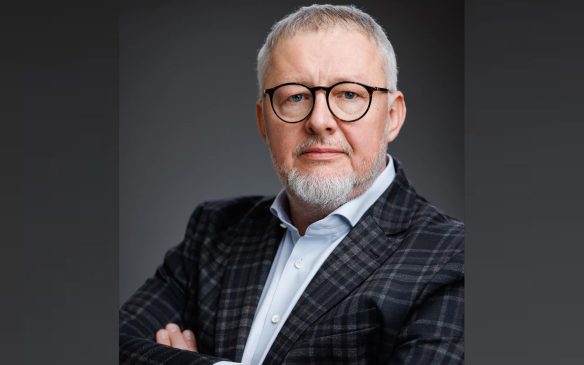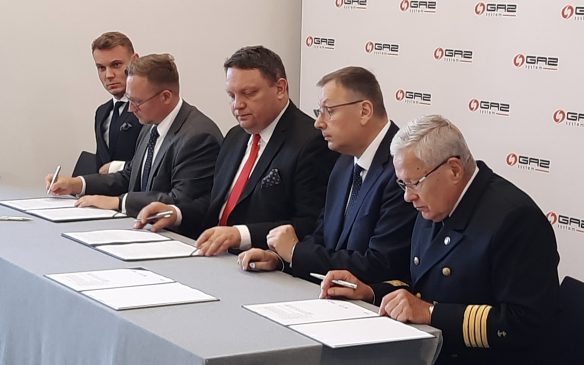Construction of the T3 quay in the Port of Gdańsk is another milestone in the development of the Polish maritime economy
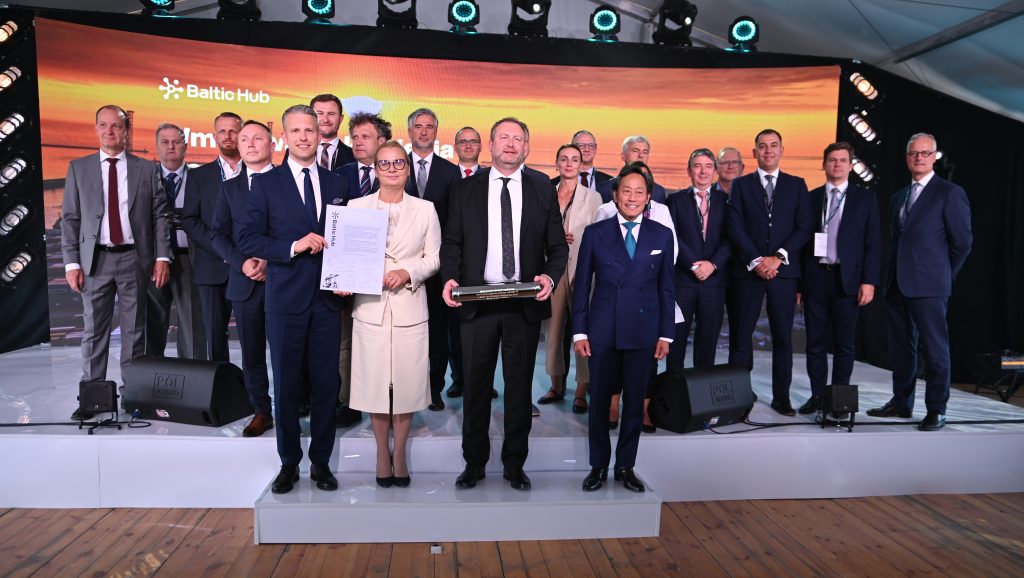
The cornerstone for the construction of the T3 quay was laid at the Baltic Hub terminal in the Port of Gdańsk. This new investment is intended to ensure new levels of quality and create new opportunities. The Baltic Hub will become one of the largest container terminals on the old continent, supporting the development of the Polish economy, the markets of Central and Eastern Europe as well as the Baltic countries. The offshore industry is also gaining momentum. The construction of Poland’s first offshore wind tower factory was celebrated on the site of the former Gdańsk Shipyard. The new investment is part of the plan to transform Pomorskie into the country’s energy centre.
Wednesday, 5 June witnessed a cornerstone-laying ceremony for two investments of key importance to the maritime economy. At the Baltic Hub in the Port of Gdańsk and the Baltic Towers on the island of Ostrów in Gdańsk, the foundation acts were signed, placed in special tubes known as time capsules, and laid under the ongoing investments. This is a message for future generations.
We need strong intermodal freight transport
The ceremony at the Baltic Hub was attended by state authorities, representatives of the Ministry of Infrastructure, the Voivodeship Office, deputies, local authorities and the management board of the Baltic Hub, representatives of the shareholders and the Port of Gdańsk Authority.
Arkadiusz Marchewka, Deputy Minister of Infrastructure, emphasised that the construction of the T3 is a special investment.
‘It is not often that we have a project that expands the territory of Poland by 36 hectares. These additional hectares are going to be our window on the great world of maritime transport, a chance for development and another step in building a strong maritime economy. Such investments are something we can be proud of. The increase in cargo handling volumes to 4.5 million TEUs means that Poland will have one of the largest terminals of its kind in Europe. I have high hopes for the future, such as in the construction of the offshore installation terminal to be built next door. The Polish government supports all investments that serve economic development. The Polish maritime economy is on the right course’, he said during the ceremony.
By increasing the cargo handling capacity of the terminal, the role of the Port of Gdańsk as a distribution centre is set to increase.
‘We are in a unique position, in the North Port, which turns 50 this year. The Baltic Hub is a little younger, soon to be 18 years old. It is the youngest part of the Port of Gdańsk and the one that is developing the most rapidly. It requires a consistent long-term effort, investment in infrastructure, especially in rail infrastructure, so that we can move cargo in and out, as this is the role of the port. We need a strong intermodal freight transport’, said Dorota Pyć, President of the Port of Gdańsk.
A lot has changed since 2007, when the first deep-water quay was built, then still under the DCT banner, reaching an annual cargo handling capacity of 500,000 TEU.
‘Eleven years ago I had the opportunity to be here for the first time, and to board a container ship that had just arrived in port. It was an extraordinary event for me. Being on the bridge seeing the horizon from one side and the other and watching these boxes, being transported from place to place, what an extraordinary jigsaw puzzle. Back then there was only the T1 quay, we were only dreaming about the T2. And now the T3 is being built’, said President Pyć.
Pride and a sense of security
Thanks to these investments, such as the construction of the new deep-water quay, Gdańsk’s position in the transport supply chain and in the warehouse logistics market will also improve.
Aleksandra Dulkiewicz, Mayor of Gdańsk, emphasised that the expansion of the Baltic Hub is something to be proud of.
‘But in addition to pride, this investment also gives a sense of security in a world where there are no guarantees’, she added.
Charles Baker, CEO of the Baltic Hub, also drew attention to the security issues. He argued that the implementation of such investments as container terminals is crucial in the current global situation. Tensions in the Red Sea and the Suez Canal, as well as the war in Ukraine, affect the course of maritime trade and much more. This makes investment in port development advisable.
Bartłomiej Pawlak, Vice-President of the Management Board of the Polish Development Fund (the Baltic Hub is owned by PSA International, IFM Global Infrastructure Fund and the Polish Development Fund) emphasised that the expansion of the terminal is a really good investment.
‘It shows what Poland can afford. It is important that PFR participates in these investment processes. I believe that in places where we are involved, the risks on the side of the State Treasury decrease. I hope that we will soon dot the i’s as far as the T5 is concerned. We have been competing for a long time over the location of the installation port for Offshore Wind Energy. We are going to prove that the T5 will be a successful terminal that serves our offshore as well’, he said.
It should be borne in mind that the construction of the T3, the third deep-water quay, began in October 2022 and its contractor is a consortium of Budimex and DEME. An artificial island has already been created, adding 36 ha to Poland’s land area. The entire extent of the dredging work has already been completed, and the next stages of construction work are now underway on the island that has been created. The new 717m-long, 17.5m-deep quay and storage yards will be equipped with state-of-the-art equipment – 7 STS quay cranes and 20 semi-automatic RMG yard cranes, the first parts of which are scheduled to be delivered as early as September 2024. The new T3 terminal is going to be semi-automated, allowing operators to remotely control equipment from ergonomically designed stations. Full completion of the T3 terminal is planned for the end of 2025.
The Baltic Hub’s cargo handling capacity will increase by 1.5 million TEUs and reach a total of 4.5 million TEUs per year, directly translating into the increased competitiveness of the Polish port sector. It is expected to have a positive impact on the economic development of both the region and the country as a whole. In 2023 the Baltic Hub handled 2.05 million TEUs, and it employs more than 1,400 people.
From shipbuilding to offshore
The offshore industry is also gaining momentum. Gdańsk’s Ostrów Island is becoming a centre for Offshore Wind Energy. A manufacturing facility for wind towers is under construction on the site of the former Gdansk shipyard. This is the first facility of its kind in Poland. The new investment aimed at the development of wind energy is a joint venture between Agencja Rozwoju Przemysłu S.A., the Spanish company GRI Renewable Industries and the Baltic Towers company set up to complete this task.
The factory, with direct access to the quay, is under construction in a place where free Poland was born. This was underlined by Michał Dąbrowski, President of Agencja Rozwoju Przemysłu (industrial development agency).
‘This is the place where history happens, it is the heart of Gdańsk. This innovative project brings us back to the first league of world business. We are starting a new chapter that consolidates the position of the city and this magnificent historical shipyard, albeit in a new version. Success starts here. And it is called Gdańsk’, he said.
The factory will be capable of producing more than 150 towers per year. More than 500 jobs will be created in the newly built plant.
Jakub Dulski, Vice-President of the Industrial Development Agency, acknowledged that the wind energy industry now has its day.
‘The success of industry in Pomorskie is the success of both Pomorskie and the entire country. This investment is set to become part of the landscape of Gdańsk for decades to come, just like the shipbuilding industry. I wish to thank all those who, on this very soil, while still in the People’s Republic of Poland, fought for freedom, for a better, richer Poland, one that can compete with the leaders of Western Europe’, he said.
Beata Rutkiewicz, the Pomorskie Voivode, reiterated the need to move away from fossil energy sources.
‘An energy transition is underway. Wind farms are a gigantic market that creates additional jobs, income for the state and the city. Pomorskie is a leader in the implementation of many strategic investments, and the first nuclear power plant in Poland is going to be built here’, she stressed.
The Baltic Towers plant is scheduled for completion in the second quarter of 2025 and is expected to become an important element in the renewable energy supply chain in Poland and Europe.
***
Agencja Rozwoju Przemysłu, on the occasion of the foundation stone laying, presented 14 commemorative plaques thanking people for their contribution to the construction of the Tri-City economy and the Gdańsk Shipyard. Those honoured include: Lech Wałęsa, Donald Tusk, Jerzy Buzek, Paweł Adamowicz, Andrzej Bojanowski, member of the Supervisory Board of the Port of Gdańsk, and Alan Aleksandrowicz, Vice President of the Port of Gdańsk.

